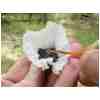
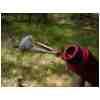
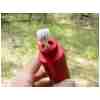
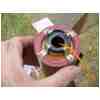
The parachute and cords are loaded normally, except that a single paper towel is inserted over the ejection piston to see if much hot gas leaks by.
After seeing it sit around unused for a couple of months, it occurred to me that this would provide a way to test smokeless powder ejection in a "normal" airframe.
So I made up an ejection charge much like those used in the previous experiments, starting with 1 gram of Red Dot and increasing the amount for subsequent tests.
The Red Dot is wrapped in one layer of 2-ply paper toweling with an electric match. The periphery of the toweling is secured with masking tape. Ignitor leads are fed through the perforated end of a 38/720 Dr. Rocket motor casing, placing the ejection charge roughly where it would be at launch.
Here is a chance to test my motor retention system.




The parachute and cords are loaded normally, except that a single paper
towel is inserted over the ejection piston to see if much hot gas leaks
by.
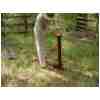
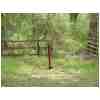
The airframe is mounted on a rod to hold it upright, the camera started,
and 110 volts sent to the ignitor...
Test 1: 1 gram Red Dot
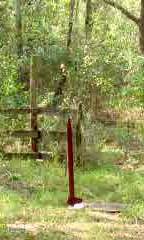
Click here for a video of this test. (About 800K download for 5 seconds of video, .mpg format) |
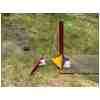 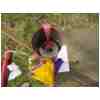 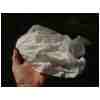 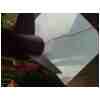 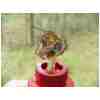
Ejection was marginal. The nose cone and parachute popped out, but the piston remained in the body tube. Paper towel was pristine, no apparent scorch-marks. But this is wimpy ejection. Time for test 2. |
| Test 2: 2 grams Red Dot
Same deal, just more powder. 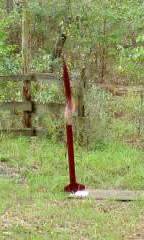
Click Here for a video of this test (800k file for 5 seconds of video) |
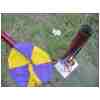 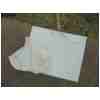 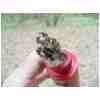
Much better, wouldn't you say? Ejection was smooth and forceful. Paper towel is still pretty, no scorch-marks. |
| Anything worth doing is worth overdoing, right?
Well, no. But I must try more. Three grams of Red Dot are bundled up. 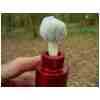 |
Test 3: 3 grams Red Dot
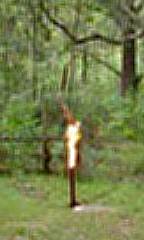
Click here for a video of this test (800k file, 5 seconds of video, .mpg format) |
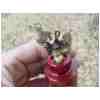
Despite the long tongue of flame, the paper towel is still undamaged, even clean. No parts were damaged in this test. |
So one more. I am thinking 2 grams gave the best overall performance,
and so will try a replication. One difference: this time the
paper towel is going under the ejection piston, where it will be exposed
directly to the burning powder.
Test 4: 2 grams Red Dot
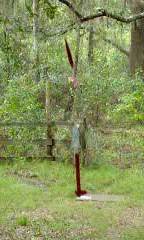
Click here for a video of this test (800k file, 5 seconds video, .mpg format) |
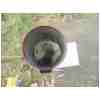  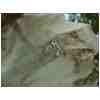 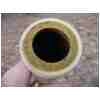 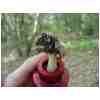
Ejection was again forceful but smooth, with no large fireball emerging from the body tube. Paper towel canary is now scorched, but surprisingly little. The end of the 38mm adapter tube shows some powder residue after these 4 tests. There is very little unburned powder, if any. |
These tests have reinforced my opinion that Red Dot could work well as an ejection charge in a rocket of this type, at least at the low altitudes commonly achieved in sport rocketry. Whether it will work in an actual launch has yet to be proven, and especially its effectiveness at very high altitude is questionable. I hope to test the first of these soon, the latter, eventually.
Comments, questions, and alternate opinions are welcomed.
Jimmy Yawn
jyawn@sfcc.net
11/7/02